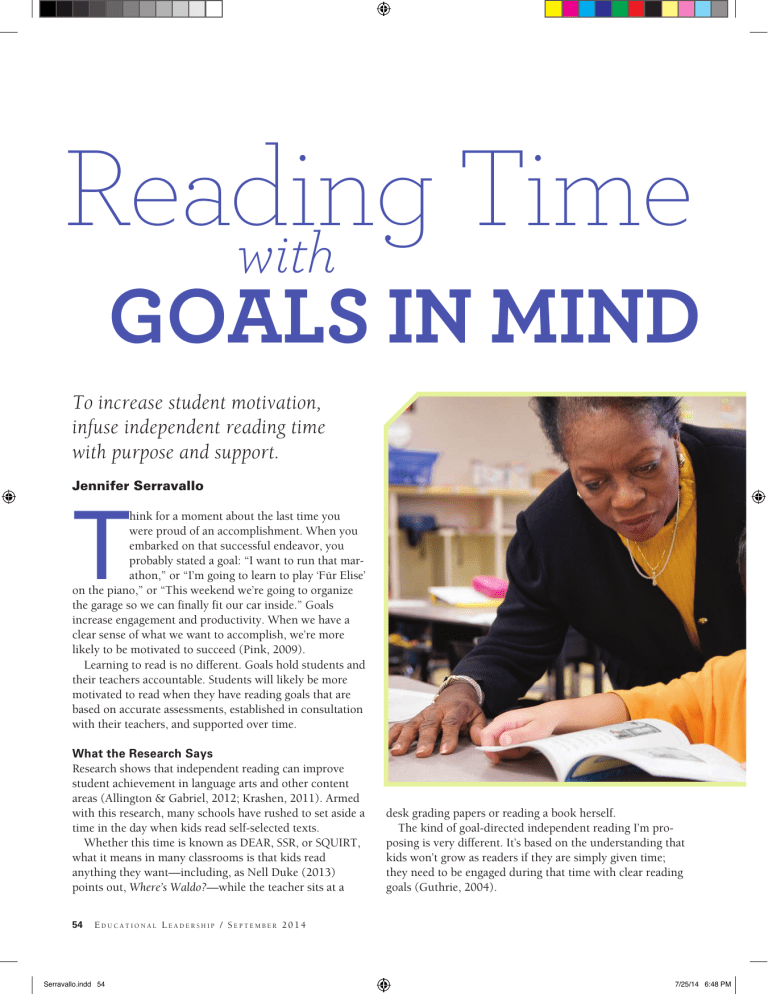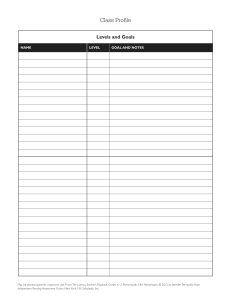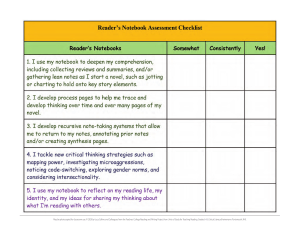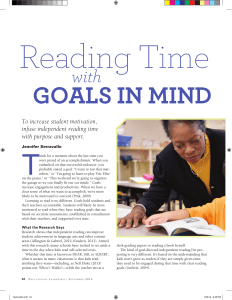
Reading Time with GOALS IN MIND To increase student motivation, infuse independent reading time with purpose and support. Jennifer Serravallo T hink for a moment about the last time you were proud of an accomplishment. When you embarked on that successful endeavor, you probably stated a goal: “I want to run that marathon,” or “I’m going to learn to play ‘Für Elise’ on the piano,” or “This weekend we’re going to organize the garage so we can finally fit our car inside.” Goals increase engagement and productivity. When we have a clear sense of what we want to accomplish, we’re more likely to be motivated to succeed (Pink, 2009). Learning to read is no different. Goals hold students and their teachers accountable. Students will likely be more motivated to read when they have reading goals that are based on accurate assessments, established in consultation with their teachers, and supported over time. What the Research Says Research shows that independent reading can improve student achievement in language arts and other content areas (Allington & Gabriel, 2012; Krashen, 2011). Armed with this research, many schools have rushed to set aside a time in the day when kids read self-selected texts. Whether this time is known as DEAR, SSR, or SQUIRT, what it means in many classrooms is that kids read anything they want—including, as Nell Duke (2013) points out, Where’s Waldo?—while the teacher sits at a 54 desk grading papers or reading a book herself. The kind of goal-directed independent reading I’m proposing is very different. It’s based on the understanding that kids won’t grow as readers if they are simply given time; they need to be engaged during that time with clear reading goals (Guthrie, 2004). EDUCATIONAL LEADERSHIP / SEPTEMBER 2014 Serravallo.indd 54 7/25/14 6:48 PM Kids won’t grow as readers if they are simply given time; they need to be engaged during that time with clear reading goals. According to the research, goals work. Petty (2006) found that “achievement is enhanced to the degree that students and teachers set and communicate appropriate, specific, and challenging goals” (p. 63). Goals have the most influence on performance when teachers provide ongoing feedback as students work toward them (Hattie, 2008). Ericsson, Krampe, and TeschRömer (1993) note that motivation comes not only from enjoyment of the task, but also from recognizing that hours of practice will yield improved © SUSIE FITZHUGH performance. They advocate “repeated experiences in which the individual can attend to the critical aspects of the situation and incrementally improve her or his performance in response to knowledge of results, feedback, or both from a teacher” (p. 398). How can you combine reading goals and independent reading practice? Let’s look at how assessment, cooperative goal-setting, support, and feedback can create a classroom that does just that. Start with Assessment In deciding on reading goals, assessment comes first. Any assessment worth its salt should be tied to everyday classroom practice. Therefore, if students are engaged in daily independent reading of selfselected texts, the most informative kind of assessment is to ask them to read texts independently and occasionally write about their thinking. Teachers can plant questions about different aspects of the text inside the book on sticky notes and ask students to respond to these questions in writing as they go along. Book logs and reading notebooks can offer valuable information about students’ reading skills and strategies. Teachers can also capture rich and essential data to inform instruction by “kidwatching” (Goodman & Owocki, 2002) and taking notes on what they notice about student engagement and behaviors during independent reading. For example, one year my literacy coach alerted me to the fact that although my students were quiet during independent reading, many of them were not engaged. I began using an engagement inventory to better understand exactly what was going on. I’d simply jot down any time I saw students reacting to their text by writing about their reading, smiling in response to something they had read, getting up to sharpen pencils, staring out the window, and so on (Serravallo, 2010). This inventory enabled me to pinpoint issues around engagement, such as which students had difficulty getting started, the number of minutes students could read before losing steam, and how often kids got distracted during independent reading. Establish Goals It’s important to look at student work and behaviors closely to determine what goal or goals will make the biggest difference in a student’s reading engagement. For some students, a goal centered around blocking out distractions, increasing stamina, or choosing appropriate books will make a world of difference. For example, if a student currently reads just a few minutes before getting distracted or losing interest, I may work with her on setting a goal to read a certain number of pages or for a certain length of time. If a student habitually abandons books midway through, I may provide instruction on how he can tap into his interests and get better at book selection (Kittle, 2013; Miller, 2009). A student who has difficulty focusing might need to be equipped with strategies for reengaging with the text when she realizes her mind is wandering. But difficulties staying focused are not always caused by simple ASCD / Serravallo.indd 55 WWW.ASCD.ORG 55 7/25/14 6:48 PM 56 on. Your skill in questioning is crucial because without leadership, students are likely to set goals that are superficial, obvious, or basic: “I want to read every night for 30 minutes,” or “I want to read faster” or “I want to read at a higher level.” This “longer, faster, more” is generally what students believe makes for a better reader. To prepare for the conference, gather only the work that would help the student notice what you have already noticed. For example, if you want the student to notice his tendency toward being distracted, you might choose to have on hand the student’s reading log (which would show a problematic page-per-minute rate) as well as your engagement inventory (which would show the number of times you noticed interruptions in the student’s reading). Alternatively, if you want a student to realize that her comprehension tends to be literal, you might gather a few samples of her writing about the text that she’s been reading that show literal retelling only and offer a comparison to a rubric or model example that shows more inferential thinking. Each goal-setting conference takes about 5–10 minutes. I usually begin by stating my intention for the conference: “We’re going to look over some of your work together and decide what one goal will make the biggest difference in your reading for the next month or two.” Next, I lay the work on the table in front of us and ask the student to look at it with me. I’ll ask the student what he or she notices about the work. An inquiry can often benefit from careful, leading questions. (See “Questions and PHOTO BY MARIA LILLY, COPYRIGHT ©2013 SCHOLASTIC, INC. USED WITH PERMISSION distractibility. Comprehension problems can also impede engagement. After all, how interesting is it to read when you don’t understand? Many elementary and middle school students need support with understanding characters, main ideas, and figurative language, to name a few challenges. Therefore, I’ve often found that setting comprehension-focused goals can improve motivation and engagement. (For suggested goal areas, see “Comprehension Goals for Fiction and Informational Texts.”) Whether the goal focuses directly on engagement (stamina, focus, book choice) or addresses an area of comprehension to improve engagement (plot, character, main idea, and so on), you’ll want to choose a goal that will make a real difference. One way to identify an important goal is to look for a pattern. Does the student demonstrate the same strengths and needs repeatedly in the same text? Do different types of work—for example, written responses in a notebook and spoken responses during a book club conversation—demonstrate a pattern? Seeing the same need more than once tells you that the need wasn’t caused by one assignment or task, and it wasn’t a result of the student missing breakfast one day or being preoccupied by an argument he had with his mom that morning. It’s also important to view this pattern not as revealing a deficit, but rather as offering an opportunity for instruction. Think about it—how motivated would you be to undertake something that feels impossible? When your goal is to run a marathon, Questions inserted at strategic spots help students check their composition. you start with one mile, then two, and so on. Running an entire marathon isn’t something you can do yet, but running one mile is. If a student can currently read for 5 uninterrupted minutes, the goal might be to extend it to 7, then 9, then 15. If a student can currently retell the beginning, middle, and end of a simple story, perhaps the goal would be to work on retelling significant events from increasingly complex plots, such as those involving flashbacks. Plan Goals Together Once you’ve noticed a pattern and identified a goal, it’s time to conduct a goal-setting conference (Serravallo, 2012, 2013a, 2013b, 2014). After this conference, you will plan strategies and methods for ongoing instruction. But first, it’s important to get the student on board. In a goal-setting conference, the role of the teacher is to lead the student through an inquiry of his or her own work. By carefully questioning the student, you can help him or her realize what’s most important to focus EDUCATIONAL LEADERSHIP / SEPTEMBER 2014 Serravallo.indd 56 7/30/14 7:03 PM Prompts to Use During Goal-Setting 12 years old in a 4th grade class, after was a classic wordcaller—a student Conferences” on p. 58.) all. who could read fluently, accurately, As soon as you and the student To determine a goal, I started with even with expression, but who didn’t have identified and established the assessment. I had her read whole comprehend (Cartwright, 2010). goal, you may find it helpful to prebooks with questions on sticky notes I tried easier and easier books until serve the conversation in writing on a planted inside that asked her to retell a I found a level at which she could sticky note, a goal card, a bookmark, section, visualize the setting, describe successfully answer at least two-thirds or a form. This tangible reminder of characters, explain the meaning of of the questions on sticky notes. Then the goal will also help the student, his vocabulary, or articulate the theme. I asked Vanessa to sit down next to or her parents, and any other service Her written responses after the first me, and I put her responses in front of providers stay focused on the work book revealed that she wasn’t making us. I asked, “Which questions do you ahead. Next, provide one clear strategy much sense of her reading. Vanessa feel were easy to answer, and which for working on the goal do you feel were a little that the student can try harder?” right away. (This strategy She pointed to the queswill be the first of many tions about character and Comprehension Goals for Fiction that you’ll introduce and theme as ones that were and Informational Texts have the student practice easy—and I agreed that her in the coming weeks.) answers to these questions When students struggle with fiction, consider Before leaving the student were strong. She pointed setting comprehension goals in these areas: to practice independently, to one of the vocabulary I always make sure to take questions and two of the n Plot and setting: determining problems and resolutions, good notes and create a three plot questions as causes and effects, and/or retelling main events. plan to follow up soon. ones that were challenging. n Character: analyzing the main and secondary characters, I commented, “Actually, inferring their traits and feelings, and explaining what their interactions tell us about the kinds of people they are. A Success Story you did a great job with n Vocabulary and figurative language: knowing how to use Vanessa is a prime example this question that asked context to figure out meaning. of a student for whom you the meaning of the n Themes and ideas: understanding overall themes, assessment, goal setting, word. Even if you didn’t unpacking symbolism, and interpreting based on social and ongoing feedback know the word before, you issues in the text. made all the difference. She figured it out. But you’re was a 4th grader the year I right—the other two quesWhen students struggle with met her when I was a staff tions seemed like they developer at her school. were harder for you, based informational text, consider Vanessa had been retained on your answers. Do you setting comprehension goals in in grade twice because she know what these questions these areas: failed her state assessments. are asking you to do?” n Main idea: synthesizing information to determine the Her teachers couldn’t Vanessa shook her head author’s main idea(s). figure out how to help her. no. I continued, “These n Key details: explaining how details from the text support Clearly there was somequestions are asking you the author’s main idea(s). thing missing, but they to talk about the events in n Vocabulary: determining the meaning of content-specific weren’t sure what. During the plot, in the order they vocabulary. independent reading, she happened, and to explain n Text features: deriving meaning from features like appeared to be on task. But why one event leads to graphs, headings, and illustrations and connecting that a closer look revealed that another.” meaning to the overall text. she was keeping up appearI asked her to tell me ances by choosing the what she thought about Sources: Independent Reading Assessment: Fiction by J. Serravallo, 2012, thickest books she could that, and she said, “Yeah, New York: Scholastic; and Independent Reading Assessment: Nonfiction by J. Serravallo, 2013, New York: Scholastic. find and pretending to be sometimes I get confused engaged in them. She was about what’s happening.” ASCD / Serravallo.indd 57 WWW.ASCD.ORG 57 7/25/14 6:48 PM I then asked her if she thought plot would be a good thing for her to focus on, and she agreed that it would be. Then, I asked her to take out the next book she’d chosen for independent reading. I introduced a strategy: using the titles of chapters to understand what the most important event in a chapter is. She read a chapter and told me when she was finished. “So Vanessa, let’s practice right now,” I suggested. “What’s the title of the chapter?” She told me, “Rats on the Roof.” I prompted, “OK, let’s think about that title and retell the chapter. What are the most important parts? Start at the beginning.” As she retold the chapter, most of the events she mentioned matched the chapter title. She got stuck toward the end, so I prompted, “Take a quick look at the last page to see if that helps.” I noticed that some of the events she listed seemed out of order and made a note that sequencing was another thing to address with her in future conferences or small-group lessons. I ended the conference by commenting, “I think this will be a good goal for you. Understanding the events of your story, in the order they happened, will help you enjoy your reading more and stay more focused.” To be honest, in the first few weeks reading at that drastically lower level, Vanessa was a bit upset with me and with her classroom teacher. Those thick books had been part of her identity as a reader, and we were making her read smaller, easier books that she could understand. But it wasn’t long before something chills-worthy happened. I was visiting the classroom and she came up to me with the biggest smile and said, “Ms. Jen, I get what you mean by ‘make a movie in your mind.’ I can actually see in my head what’s happening in the book. I under58 Questions and Prompts to Use During Goal-Setting Conferences ? What can you notice about your work? How does your work compare to [provide work of another student, an author, or exemplar]? n Can you think of any ways that you might improve your work? n Let’s talk about some of the things you think you’re good at as a reader. n What do you think might be a good goal for you based on what we’ve noticed? n When you look at your work, what are some things you seem to struggle with? n Is there anything you notice from this [rubric, other student’s work, and so on] that you think you’d like to try to start doing? n What’s going to make the biggest difference for you as a reader? n What is some new work you think you’re ready to start taking on? n One thing I notice is ______. What are your thoughts about that? n n Sources: Literacy Teacher’s Playbook K–2 and 3–6 by J. Serravallo, 2013 and 2014, Portsmouth, NH: Heinemann. Running an entire marathon isn’t something you can do yet, but running one mile is. stand what’s happening!” She started devouring books, not just in class but also at home. She wanted to read texts she could understand, so she stopped trying to sneak in thick chapter books and instead opted for just-right reading materials. Her classroom teacher continued to work with her on this goal, reassessed her at a higher level after a few weeks and set a new goal, and on and on for the remainder of the year. That year, Vanessa passed her state test. But even more important, she started to love reading. She found joy in something she used to fake. A Whole New Level It’s a powerful shift when we move from the “Drop Everything and Read” view of independent reading to a goaldirected independent reading time. To me, this approach takes the best of the recent research about the power of independent reading and combines it with research about the power of goal setting and feedback. When students are focused on goals that they had a hand in choosing, it brings reading engagement, motivation, and progress to a whole new level. EL References Allington, R. L., & Gabriel, R. E. (2012). Every child, every day. Educational Leadership, 69(8), 10–15. Cartwright, K. (2010). Wordcallers: Smallgroup and one-on-one interventions for children who “read” but don’t comprehend. Portsmouth, NH: Heinemann. Duke, N. K. (2013). Introduction. In D. Miller & B. Moss (Eds.), No more independent reading without support. Portsmouth, NH: Heinemann. Ericsson, K. A., Krampe, R., & Tesch- EDUCATIONAL LEADERSHIP / SEPTEMBER 2014 Serravallo.indd 58 7/25/14 6:49 PM Stu den t Le arn ing Tar get s Römer, C. (1993). The role of deliberate practice in the acquisition of expert performance. Psychological Review, 100(3), 363–406. Goodman, Y., & Owocki, G. (2002). Kidwatching: Documenting children’s literacy development. Portsmouth, NH: Heinemann. Guthrie, J. T. (2004). Teaching for literacy engagement. Journal of Literacy Research, 36(1), 1–29. Hattie, J. (2008). Visible learning: A synthesis of over 800 meta-analyses related to achievement. New York: Routledge. Kittle, P. (2013). Book love: Developing depth, passion, and stamina in adolescent readers. Portsmouth, NH: Heinemann. Krashen, S. (2011). Free voluntary reading. Santa Barbara, CA: Libraries Unlimited. Miller, D. (2009). The book whisperer: Awakening the inner reader in every child. San Francisco: Wiley. Petty, G. (2006). Evidence-based teaching: A practical approach. Cheltenham, UK: Nelson Thornes. Pink, D. (2009). Drive: The surprising truth about what motivates us. New York: Riverhead. Serravallo, J. (2010). Teaching reading in small groups: Differentiated instruction for building strategic, independent readers. Portsmouth, NH: Heinemann. Serravallo, J. (2012). Independent reading assessment: Fiction. New York: Scholastic. Serravallo, J. (2013a). Independent reading assessment: Nonfiction. New York: Scholastic. Serravallo, J. (2013b). The literacy teacher’s playbook, 3–6: Four steps for turning assessment data into goaldirected instruction. Portsmouth, NH: Heinemann. Serravallo, J. (2014). The literacy teacher’s playbook, K–2: Four steps for turning assessment data into goaldirected instruction. Portsmouth, NH: Heinemann. Jennifer Serravallo (jserravallo@ gmail.com; www.jenniferserravallo .com) is a literacy consultant, speaker, and author. Her books include The Literacy Teacher’s Playbook: Four Steps for Turning Assessment Data into Goal-Directed Instruction, K–2 and 3–6 (Heinemann, 2013, 2014). She is on Twitter @jserravallo. Read ing T estle t Blu eprin t To gathe r evid ence of stude nt un dersta nding to Time Neede d for | Tota Adm l Scor inistr e: 10 ation: poin ts 20 m inute s Item (M Type (DOK ) C/CR *) # of Item s Ite Posi m tion MC 1 6 MC 1 5 MC 1 the re as releva oning is so nt an d suffi und and Analy th cient ze ho to su e evidence writi w tw ppor is ng o t the presen about th or more claim au e s. emph tations of same to thors pi as differ izing diff key inform c shape th ent in er eir terpre ent evid ation by ence tation or s of fa adva ncing cts. 4 MC 1 1 3 MC 1 3 3 3 MC 1 2 CR 1 7 Tools for Back to School Prepare for success this fall with Measured Progress COMMON CORE™ Assessments. Focus your instruction with items and assessments built directly to the Common Core. Support formative assessment practices with our Item Bank, Testlets, and Benchmarks. To learn more about Measured Progress COMMON CORE Assessments, visit measuredprogress.org/commoncore. ASCD / Serravallo.indd 59 inform instru ction . WWW.ASCD.ORG 59 7/25/14 6:49 PM Copyright of Educational Leadership is the property of Association for Supervision & Curriculum Development and its content may not be copied or emailed to multiple sites or posted to a listserv without the copyright holder's express written permission. However, users may print, download, or email articles for individual use.



